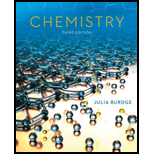
Concept explainers
Interpretation:
The names of the given coordination complexes are to be determined.
Concept introduction:
Coordination compounds are the compounds that are formed by the reaction of metal ions with polar molecules, or with a group of anions. They contain coordinate covalent bonds.
For each coordination compound, the name of the cation is first and the name of the anion is second.
The name of anionic ligand ends with letter “o”
The neutral ligands are called by the name of the molecule except
Prefixes di, tri, tetra, penta and hexa are used, to specify the number of ligands when two or more of same ligands are present.
The oxidation number of the metal is written after the name of the metal in roman numerals.
If the complex is an anion, its name ends with ‘-ate’.
Want to see the full answer?
Check out a sample textbook solution
Chapter 22 Solutions
Chemistry-Connect Plus Access
- A coordination compound of ruthenium, [Ru(NH3)4Cl2]Cl, has shown some activity against leukemia in animal studies. Give the formula for the counter ionarrow_forwardGive the systematic name for the following coordination compound: Na[Ag(CN)₂arrow_forwardWhat is a transition metal in the fourth period from the following list: N, Cu, Ag, Yb?arrow_forward
- Consider the pseudo-octahedral complex ion of Cr3+, where A and B represent ligands. Ligand A produces a stronger crystal field than ligand B. Draw an appropriate crystal field diagram for this complex ion (assume the A ligands are on the z-axis).arrow_forwardThe coordination complex [Cr(CO)6] forms colorless, diamagnetic crystals that melt at 90 °C. Given that [Cr(CO)6] is diamagnetic, what is the electron configuration of chromium in this compound?arrow_forwardConsidering that [Cr (OH2) 6] Cl3 compound is purple, [Cr (NH3) 6] Cl3 compound is yellow, which of the following statements is wrong according to the Crystal Field Theory about these compounds? (24Cr) (Use the color circle given in the figure) A. Since both chromium metal ions carry 3 unpaired electrons, they show paramagnetic properties.B. The Δo calculated for [Cr (OH2) 6] 3+ is smaller than the Δo value calculated for [Cr (NH3) 6] 3+.C. [Cr (OH2) 6] Cl3 reflects light in the wavelength range of about 4000-4200 angstroms.D. For [Cr (NH3) 6] 3+, Δo is calculated by directly using the energy of yellow light.arrow_forward
- The coordination complex [Cr(CO)6] forms colorless, diamagnetic crystals that melt at 90 °C. Given that [Cr(CO)6] is colorless, would you expect CO to be a weak-field or strong-field ligand?arrow_forwardcoordination number of Co^3+ complex is a 3 b 4 c 5 d 6arrow_forwardWhat is the valence electron number and effective atomic number of the [CrCl3 (NH3) 3] coordination compound?arrow_forward
- Considering Br as a weak field ligand , the number of unpaired electrons in [Co(Br))6]2- will be (Atomic number Co= 27)arrow_forwardoxidation number of the transition metal ion in K2 Febr4 Cu+ with CH3CN to form a coordination compound and which going to Lewis acid and which going to Lewis base how many 3d electrons in Cr(CN)2Cl2arrow_forwardAssign reason for each of the following :(i) Transition elements exhibit paramagnetic behaviour.(ii) Co2+. is easily oxidised in the presence of a strong ligand.arrow_forward
 ChemistryChemistryISBN:9781305957404Author:Steven S. Zumdahl, Susan A. Zumdahl, Donald J. DeCostePublisher:Cengage Learning
ChemistryChemistryISBN:9781305957404Author:Steven S. Zumdahl, Susan A. Zumdahl, Donald J. DeCostePublisher:Cengage Learning Chemistry: An Atoms First ApproachChemistryISBN:9781305079243Author:Steven S. Zumdahl, Susan A. ZumdahlPublisher:Cengage Learning
Chemistry: An Atoms First ApproachChemistryISBN:9781305079243Author:Steven S. Zumdahl, Susan A. ZumdahlPublisher:Cengage Learning
 General Chemistry - Standalone book (MindTap Cour...ChemistryISBN:9781305580343Author:Steven D. Gammon, Ebbing, Darrell Ebbing, Steven D., Darrell; Gammon, Darrell Ebbing; Steven D. Gammon, Darrell D.; Gammon, Ebbing; Steven D. Gammon; DarrellPublisher:Cengage Learning
General Chemistry - Standalone book (MindTap Cour...ChemistryISBN:9781305580343Author:Steven D. Gammon, Ebbing, Darrell Ebbing, Steven D., Darrell; Gammon, Darrell Ebbing; Steven D. Gammon, Darrell D.; Gammon, Ebbing; Steven D. Gammon; DarrellPublisher:Cengage Learning Chemistry: The Molecular ScienceChemistryISBN:9781285199047Author:John W. Moore, Conrad L. StanitskiPublisher:Cengage Learning
Chemistry: The Molecular ScienceChemistryISBN:9781285199047Author:John W. Moore, Conrad L. StanitskiPublisher:Cengage Learning




